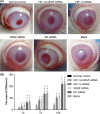Inhibited corneal neovascularization in rabbits following corneal alkali burn by double-target interference for VEGF and HIF-1α
- PMID: 30355648
- PMCID: PMC6356011
- DOI: 10.1042/BSR20180552
Inhibited corneal neovascularization in rabbits following corneal alkali burn by double-target interference for VEGF and HIF-1α
Retraction in
-
Retraction: Inhibited corneal neovascularization in rabbits following corneal alkali burn by double-target interference for VEGF and HIF-1α.Biosci Rep. 2024 Jun 26;44(6):BSR-2018-0552_RET. doi: 10.1042/BSR-2018-0552_RET. Biosci Rep. 2024. PMID: 38818949 Free PMC article. No abstract available.
Abstract
Expression of hypoxia-inducible factor (HIF) 1α has been observed in corneal neovascularization (CNV). Vascular endothelial growth factor (VEGF), one of the most well-known angiogenic factors in CNV, is under the regulation of HIF-1. The present study aims to investigate the synergistic effects of VEGF and HIF-1α gene silencing on alkali burn-induced CNV in rabbits. The models of rabbits in corneal alkali burn were established. SiRNA recombinant adenovirus was used to explore the synergistic effects of VEGF and HIF-1α gene silencing on alkali burn-induced CNV. CNV area and ultrastructure of cornea were observed. The expression of VEGF and HIF-1α was detected. CNV was observed in rabbits following alkali burn. In addition, overexpressed VEGF and HIF-1α was also observed in rabbits following alkali burn. Then, silencing HIF-1α or silencing VEGF decreased area of CNV, inhibited neovascularization and improved pathological changes, while double-target interference for VEGF and HIF-1α decreased area of CNV inhibited neovascularization, and improved pathological changes to a greater extent. Our study provides evidences emphasizing the distinct notion that VEGF and HIF-1α play the contributory role in alkali burn-induced CNV as a result of double-target interference for VEGF and HIF-1α inhibiting CNV in rabbits following corneal alkali burn.
Keywords: Alkali burn; Cornea neovascularization; Gene silencing; HIF-1α; Rabbit model; Synergistic effect; VEGF.
© 2019 The Author(s).
Conflict of interest statement
The authors declare that there are no competing interests associated with the manuscript.
Figures






Similar articles
-
Inhibitory effects of S100A4 gene silencing on alkali burn-induced corneal neovascularization: an in vivo study.Mol Vis. 2017 Apr 26;23:286-295. eCollection 2017. Mol Vis. 2017. PMID: 28479848 Free PMC article.
-
miR-497 knockout aggravates alkali burn-induced corneal neovascularization via VEGFA and FGF2 pathways in mice models.Int Ophthalmol. 2025 Aug 12;45(1):328. doi: 10.1007/s10792-025-03691-3. Int Ophthalmol. 2025. PMID: 40794317 Free PMC article.
-
KH902, a recombinant human VEGF receptor fusion protein, reduced the level of placental growth factor in alkali burn induced-corneal neovascularization.Ophthalmic Res. 2013;50(3):180-6. doi: 10.1159/000353437. Epub 2013 Sep 4. Ophthalmic Res. 2013. PMID: 24008241
-
TLR4 signal inhibition alleviates alkali-burn induced corneal neovascularization.Exp Eye Res. 2025 Sep;258:110486. doi: 10.1016/j.exer.2025.110486. Epub 2025 Jun 15. Exp Eye Res. 2025. PMID: 40527362
-
Research progress on the correlation between corneal neovascularization and lymphangiogenesis (Review).Mol Med Rep. 2025 Feb;31(2):47. doi: 10.3892/mmr.2024.13412. Epub 2024 Dec 5. Mol Med Rep. 2025. PMID: 39635819 Free PMC article. Review.
Cited by
-
Immunohistochemical study of STAT3, HIF-1α and VEGF in pterygium and normal conjunctiva: Experimental research and literature review.Mol Vis. 2020 Jul 26;26:510-516. eCollection 2020. Mol Vis. 2020. PMID: 32753832 Free PMC article.
-
The effect of vacuum sealing drainage after early woundabrasion on wound healing in diabetic patients with deep second degree burn and its influence on the inflammatory response.Am J Transl Res. 2021 Aug 15;13(8):9814-9819. eCollection 2021. Am J Transl Res. 2021. PMID: 34540115 Free PMC article.
-
Ocular lamellar crystalline gels for sustained release and enhanced permeation of resveratrol against corneal neovascularization.Drug Deliv. 2021 Dec;28(1):206-217. doi: 10.1080/10717544.2021.1872739. Drug Deliv. 2021. PMID: 33472443 Free PMC article.
-
Effective treatment of retinal neovascular leakage with fusogenic porous silicon nanoparticles delivering VEGF-siRNA.Nanomedicine (Lond). 2022 Nov;17(27):2089-2108. doi: 10.2217/nnm-2022-0255. Epub 2023 Feb 7. Nanomedicine (Lond). 2022. PMID: 36748946 Free PMC article.
-
Melatonin exerts anti-angiogenic and anti-inflammatory effects in alkali-burned corneas.Ann Transl Med. 2022 Apr;10(8):432. doi: 10.21037/atm-21-4927. Ann Transl Med. 2022. PMID: 35571431 Free PMC article.
References
Publication types
MeSH terms
Substances
LinkOut - more resources
Full Text Sources

